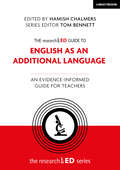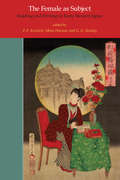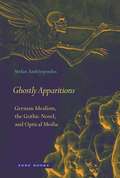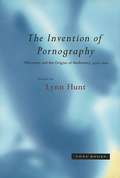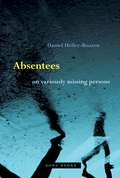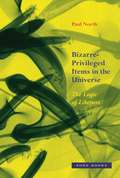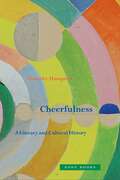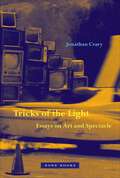- Table View
- List View
Tried and tested: The ultimate guide to teaching primary languages
by Juliet Park Wendy AdenijiThis book provides you with practical, easy-to-implement classroom ideas and strategies for teaching and leading MFL in a primary school and will support you to prepare for MFL Ofsted ‘deep dives’. There are a huge amount of practical ideas provided, from curriculum design, long, medium and short term planning with real examples in French and Spanish, so you can see how it works in practice. Challenge, differentiation and mixed age teaching are covered, as well as motivating and way to teach vocabulary, phonics and grammar. Linked to the 2019 Ofsted inspection framework and in line with the KS2 National Curriculum programme of study, chapters are devoted to memory and cultural capital, as well as innovative strategies to use stories and songs. Readers will learn how to assess using ‘age-related expectations’ and you will be able to access real examples of lesson plans, curriculum planning documents and resources.
The researchED Guide to English as an Additional Language: An Evidence-informed Guide For Teachers (researchED)
by Tom Bennett Hamish ChalmersIn this edition, Hamish Chalmers provides a primer on the key questions teachers and researchers have about the education of children learning English as an Additional Language (EAL). From the general implications of teaching children in a language that many are still in the process of learning, to the specifics of EAL-friendly pedagogy, this volume includes contributions from both teachers and researchers in the field: Victoria Murphy, Constant Leung, Jonathan Bifield, Feyisa Demie, Ann-Margaret Smith, Naomi Flynn, Holly Joseph, Tracey Costley, Xiao Lan Curdt-Christiansen, and Eowyn Crisfield.Hamish Chalmers is a lecturer and EAL researcher at the University of Oxford, vice-chair of NALDIC — the UK’s EAL subject association — and erstwhile primary school teacher, both in the UK and overseas.
The Female as Subject: Reading and Writing in Early Modern Japan (Michigan Monograph Series in Japanese Studies #70)
by P. F. Kornicki Mara Patessio G. G. RowleyMichigan Monograph Series in Japanese Studies No. 70 The Female as Subject reveals the rich and lively world of literate women in Japan from 1600 through the early twentieth century. Eleven essays by an international group of scholars from Europe, Japan, and North America examine what women of different social classes read, what books were produced specifically for women, and the genres in which women themselves chose to write. The authors explore the different types of education women obtained and the levels of literacy they achieved, and they uncover women’s participation in the production of books, magazines, and speeches. The resulting depiction of women as readers and writers is also enhanced by thirty black-and-white illustrations. For too long, women have been largely absent from accounts of cultural production in early modern Japan. By foregrounding women, the essays in this book enable us to rethink what we know about Japanese society during these centuries. The result is a new history of women as readers, writers, and culturally active agents. The Female as Subject is essential reading for all students and teachers of Japan during the Edo and Meiji periods. It also provides valuable comparative data for scholars of the history of literacy and the book in East Asia.
No One’s Ways: An Essay on Infinite Naming (Zone Bks.)
by Daniel Heller-RoazenHomer recounts how, trapped inside a monster’s cave, with nothing but his wits, Ulysses once saved himself by twisting his name. He called himself Outis: “No One” or “Non-One,” “No Man” or “Non-Man.” The ploy was a success. He blinded his barbaric host and eluded him, becoming anonymous, for a while, even as he bore a name.Philosophers never forgot the lesson that the ancient hero taught. From Aristotle and his commentators in Greek, Arabic, Latin, and more modern languages, from the masters of the medieval schools to Kant and his many successors, thinkers have exploited the possibilities of adding “non-” to the names of man.Aristotle is the first to write of “indefinite” or “infinite” names, his example being “non-man.” Kant turns to such terms in his theory of the infinite judgment, illustrated by the sentence, “The soul is non-_mortal.” Such statements play unexpected and often major roles in the systems of Salomon Maimon, Hegel and Hermann Cohen, before being variously and profoundly reinterpreted in the twentieth century.Reconstructing the adventures of a particle in philosophy, Heller-Roazen’s book shows how a grammatical possibility can be an incitement for thought. Yet it also draws a lesson from persistent examples. The philosophers’ infinite names all point to one subject: us. “Non-man” or “soul,” “Spirit” or “the unconditioned,” we are beings who name and name ourselves, bearing witness to the fact that we are, in every sense, unnamable.
Ghostly Apparitions: German Idealism, the Gothic Novel, and Optical Media (Zone Bks.)
by Stefan AndriopoulosDrawing together literature, media, and philosophy, Ghostly Apparitions provides a new model for media archaeology and its transformation of intellectual and literary history. Stefan Andriopoulos examines new media technologies and distinct cultural realms, tracing connections between Kant’s philosophy and the magic lantern’s phantasmagoria, the Gothic novel and print culture, and spiritualist research and the invention of television.As Kant was writing about the possibility of spiritual apparitions, the emerging medium of the phantasmagoria used hidden magic lanterns to startle audiences with ghostly projections. Andriopoulos juxtaposes the philosophical arguments of German idealism with contemporaneous occultism and ghost shows. In close readings of Kant, Hegel, and Schopenhauer, he traces the diverging modes in which these authors appropriated figures of optical media and spiritualist notions.The spectral apparitions from this period also intersect with the rise of popular print culture. Andriopoulos explores the circulation of ostensibly authentic ghost narratives and the Gothic novel, which was said to produce “reading addiction” and a loss of reality. Romantic representations of animal magnetism and clairvoyance similarly blurred the boundary between fiction and reality.The final chapter of Ghostly Apparitions extends this archaeology of new media into the early twentieth century. Tracing a reciprocal inter_action between occultism and engineering, Andriopoulos uncovers how theories and devices of psychical research enabled the emergence of television.
The Invention of Pornography: Obscenity and the Origins of Modernity, 1500–1800 (Zone Bks.)
by Lynn HuntIn this groundbreaking collection of essays, historians and literary theorists examine how, between 1500 and 1800, pornography emerged as a literary practice and a category of knowledge intimately linked to the formative moments of Western modernity and the democratization of culture. The first modern writers and engravers of pornography were part of the demimonde of heretics, freethinkers, and libertines who constituted the dark underside of the Renaissance, the Scientific Revolution, the Enlightenment, and the French Revolution. From the start, early modern European pornography used the shock of sex to test the boundaries and regulation of obscene behavior and expression in the public and private sphere. As such, pornography criticized and even subverted political authorities as well as social and sexual relations.
Absentees: On Variously Missing Persons
by Daniel Heller-RoazenAn intellectually adventurous account of the role of nonpersons that explores their depiction in literature and challenges how they are defined in philosophy, law, and anthropology In thirteen interlocking chapters, Absentees explores the role of the missing in human communities, asking an urgent question: How does a person become a nonperson, whether by disappearance, disenfranchisement, or civil, social, or biological death? Only somebody can become a “nobody,” but, as Daniel Heller-Roazen shows, the ways of being a nonperson are as diverse and complex as they are mysterious and unpredictable. Heller-Roazen treats the variously missing persons of the subtitle in three parts: Vanishings, Lessenings, and Survivals. In each section and with multiple transhistorical and transcultural examples, he challenges the categories that define nonpersons in philosophy, ethics, law, and anthropology. Exclusion, infamy, and stigma; mortuary beliefs and customs; children’s games and state censuses; ghosts and “dead souls” illustrate the lives of those lacking or denied full personhood. In the archives of fiction, Heller-Roazen uncovers figurations of the missing—from Helen of Argos in Troy or Egypt to Hawthorne’s Wakefield, Swift’s Captain Gulliver, Kafka’s undead hunter Gracchus, and Chamisso’s long-lived shadowless Peter Schlemihl. Readers of The Enemy of All and No One’s Ways will find a continuation of those books’ intense intellectual adventures, with unexpected questions and arguments arising every step of the way. In a unique voice, Heller-Roazen’s thought and writing capture the intricacies of the all-too-human absent and absented.
Absentees: On Variously Missing Persons
by Daniel Heller-RoazenAn intellectually adventurous account of the role of nonpersons that explores their depiction in literature and challenges how they are defined in philosophy, law, and anthropology In thirteen interlocking chapters, Absentees explores the role of the missing in human communities, asking an urgent question: How does a person become a nonperson, whether by disappearance, disenfranchisement, or civil, social, or biological death? Only somebody can become a “nobody,” but, as Daniel Heller-Roazen shows, the ways of being a nonperson are as diverse and complex as they are mysterious and unpredictable. Heller-Roazen treats the variously missing persons of the subtitle in three parts: Vanishings, Lessenings, and Survivals. In each section and with multiple transhistorical and transcultural examples, he challenges the categories that define nonpersons in philosophy, ethics, law, and anthropology. Exclusion, infamy, and stigma; mortuary beliefs and customs; children’s games and state censuses; ghosts and “dead souls” illustrate the lives of those lacking or denied full personhood. In the archives of fiction, Heller-Roazen uncovers figurations of the missing—from Helen of Argos in Troy or Egypt to Hawthorne’s Wakefield, Swift’s Captain Gulliver, Kafka’s undead hunter Gracchus, and Chamisso’s long-lived shadowless Peter Schlemihl. Readers of The Enemy of All and No One’s Ways will find a continuation of those books’ intense intellectual adventures, with unexpected questions and arguments arising every step of the way. In a unique voice, Heller-Roazen’s thought and writing capture the intricacies of the all-too-human absent and absented.
Bizarre-Privileged Items in the Universe: The Logic of Likeness
by Professor Paul NorthAn imaginative new theory of likeness that ranges widely across history and subjects, from physics and evolution to psychology, language, and artA butterfly is like another butterfly. A butterfly is also like a leaf and at the same time like a paper airplane, an owl’s face, a scholar flying from book to book. The most disparate things approach one another in a butterfly, the sort of dense nodule of likeness that Roger Caillois once proposed calling a “bizarre-privileged item.” In response, critical theorist Paul North proposes a spiritual exercise: imagine a universe made up solely of likenesses. There are no things, only traits acting according to the law of series, here and there a thick overlap that appears “bizarre.”Centuries of thought have fixated on the concept of difference. This book offers a theory that begins from likeness, where, at any instant, a vast array of series proliferates and remote regions come into contact. Bizarre-Privileged Items in the Universe follows likenesses as they traverse physics and the physical universe; evolution and evolutionary theory; psychology and the psyche; sociality, language, and art. Divergent sources from an eccentric history help give shape to a new trans-science, “homeotics.”
Bizarre-Privileged Items in the Universe: The Logic of Likeness
by Professor Paul NorthAn imaginative new theory of likeness that ranges widely across history and subjects, from physics and evolution to psychology, language, and artA butterfly is like another butterfly. A butterfly is also like a leaf and at the same time like a paper airplane, an owl’s face, a scholar flying from book to book. The most disparate things approach one another in a butterfly, the sort of dense nodule of likeness that Roger Caillois once proposed calling a “bizarre-privileged item.” In response, critical theorist Paul North proposes a spiritual exercise: imagine a universe made up solely of likenesses. There are no things, only traits acting according to the law of series, here and there a thick overlap that appears “bizarre.”Centuries of thought have fixated on the concept of difference. This book offers a theory that begins from likeness, where, at any instant, a vast array of series proliferates and remote regions come into contact. Bizarre-Privileged Items in the Universe follows likenesses as they traverse physics and the physical universe; evolution and evolutionary theory; psychology and the psyche; sociality, language, and art. Divergent sources from an eccentric history help give shape to a new trans-science, “homeotics.”
Cheerfulness: A Literary and Cultural History
by Timothy HamptonA timely story of a forgotten emotionCheerfulness: A Literary and Cultural History tells a new story about the cultural imagination of the West wherein cheerfulness — a momentary uptick in emotional energy, a temporary lightening of spirit — functions as a crucial theme in literary, philosophical, and artistic creations from early modern to contemporary times. In dazzling interpretations of Shakespeare and Montaigne, Hume, Austen and Emerson, Dickens, Nietzsche, and Louis Armstrong, Hampton explores the philosophical construal of cheerfulness — as a theme in Protestant theology, a focus of medical writing, a topic in Enlightenment psychology, and a category of modern aesthetics. In a conclusion on cheerfulness in pandemic days, Hampton stresses the importance of lightness of mind under the pressure of catastrophe. A history of the emotional life of European and American cultures, a breathtaking exploration of the intersections of culture, literature, and psychology, Cheerfulness challenges the dominant narrative of Western aesthetics as a story of melancholy, mourning, tragedy, and trauma. Hampton captures the many appearances of this fleeting and powerfully transformative emotion whose historical and literary trajectory has never before been systematically traced.
Cheerfulness: A Literary and Cultural History
by Timothy HamptonA timely story of a forgotten emotionCheerfulness: A Literary and Cultural History tells a new story about the cultural imagination of the West wherein cheerfulness — a momentary uptick in emotional energy, a temporary lightening of spirit — functions as a crucial theme in literary, philosophical, and artistic creations from early modern to contemporary times. In dazzling interpretations of Shakespeare and Montaigne, Hume, Austen and Emerson, Dickens, Nietzsche, and Louis Armstrong, Hampton explores the philosophical construal of cheerfulness — as a theme in Protestant theology, a focus of medical writing, a topic in Enlightenment psychology, and a category of modern aesthetics. In a conclusion on cheerfulness in pandemic days, Hampton stresses the importance of lightness of mind under the pressure of catastrophe. A history of the emotional life of European and American cultures, a breathtaking exploration of the intersections of culture, literature, and psychology, Cheerfulness challenges the dominant narrative of Western aesthetics as a story of melancholy, mourning, tragedy, and trauma. Hampton captures the many appearances of this fleeting and powerfully transformative emotion whose historical and literary trajectory has never before been systematically traced.
Civic Storytelling: The Rise of Short Forms and the Agency of Literature
by Florian FuchsA deep history of storytelling as a civic agency, recalibrating literature’s political role for the twenty-first centuryWhy did short narrative forms like the novella, fable, and fairy tale suddenly emerge around 1800 as genres symptomatic of literature’s role in life and society? In order to explain their rapid ascent to such importance, Florian Fuchs identifies an essential role of literature, a role traditionally performed within classical civic discourse of storytelling, by looking at new or updated forms of this civic practice in modernity. Fuchs's focus in this groundbreaking book is on the fate of topical speech, on what is exchanged between participants in argument or conversation as opposed to rhetorical speech, which emanates from and ensures political authority. He shows how after the decline of the Ars topica in the eighteenth century, various forms of literary speech took up the role of topical speech that Aristotle had originally identified. Thus, his book outlines a genealogy of various literary short forms—from fable, fairy tale, and novella to twenty-first century video storytelling—that attempted on both "high" and "low" levels of culture to exercise again the social function of topical speech. Some of the specific texts analyzed include the novellas of Theodor Storm and the novella-like lettre de cachet, proverbial fictions of Gustave Flaubert and Gottfried Keller, the fairy tale as rediscovered by Vladimir Propp and Walter Benjamin, the epiphanies of James Joyce, and the video narratives of Hito Steyerl.
Civic Storytelling: The Rise of Short Forms and the Agency of Literature
by Florian FuchsA deep history of storytelling as a civic agency, recalibrating literature’s political role for the twenty-first centuryWhy did short narrative forms like the novella, fable, and fairy tale suddenly emerge around 1800 as genres symptomatic of literature’s role in life and society? In order to explain their rapid ascent to such importance, Florian Fuchs identifies an essential role of literature, a role traditionally performed within classical civic discourse of storytelling, by looking at new or updated forms of this civic practice in modernity. Fuchs's focus in this groundbreaking book is on the fate of topical speech, on what is exchanged between participants in argument or conversation as opposed to rhetorical speech, which emanates from and ensures political authority. He shows how after the decline of the Ars topica in the eighteenth century, various forms of literary speech took up the role of topical speech that Aristotle had originally identified. Thus, his book outlines a genealogy of various literary short forms—from fable, fairy tale, and novella to twenty-first century video storytelling—that attempted on both "high" and "low" levels of culture to exercise again the social function of topical speech. Some of the specific texts analyzed include the novellas of Theodor Storm and the novella-like lettre de cachet, proverbial fictions of Gustave Flaubert and Gottfried Keller, the fairy tale as rediscovered by Vladimir Propp and Walter Benjamin, the epiphanies of James Joyce, and the video narratives of Hito Steyerl.
Preexisting Conditions: Recounting the Plague
by Samuel WeberA stunning philosophical and literary account of canonical plague talesMany are the losses suffered and lives lost during the recent COVID-19 pandemic. Since 2020, writers around the globe have penned essays and books that make sense of this medical and public health catastrophe. But few have addressed a pressing question that precedes and is the foundation of their writings: How does the very act of narrating the pandemic offer strategies to confront and contend with the pandemic’s present dangers? What narratives have been offered during past plague and pandemic times to ease suffering and loss and protect individuals and communities from a life lived under the most precarious of conditions? The philosopher and literary and cultural critic Samuel Weber returns to past narratives of plagues and pandemics to reproduce the myriad ways individual and collective, historical and actual, intentional and unintentional forces converge to reveal how cultures and societies deal with their vulnerability and mortality. The “preexisting conditions”—a phrase taken from the American healthcare industry—of these very cultures converge and collide with the urgent situations of individuals confronting the plague. Texts drawn from the Bible, Sophocles, Thucydides, Boccaccio, Luther, Defoe, Kleist, Hölderlin, Artaud, and Camus demonstrate how in the process of narration individuals come to reconsider their relationship to others, to themselves, and to the collectives to which they belong and on which they depend.
Preexisting Conditions: Recounting the Plague
by Samuel WeberA stunning philosophical and literary account of canonical plague talesMany are the losses suffered and lives lost during the recent COVID-19 pandemic. Since 2020, writers around the globe have penned essays and books that make sense of this medical and public health catastrophe. But few have addressed a pressing question that precedes and is the foundation of their writings: How does the very act of narrating the pandemic offer strategies to confront and contend with the pandemic’s present dangers? What narratives have been offered during past plague and pandemic times to ease suffering and loss and protect individuals and communities from a life lived under the most precarious of conditions? The philosopher and literary and cultural critic Samuel Weber returns to past narratives of plagues and pandemics to reproduce the myriad ways individual and collective, historical and actual, intentional and unintentional forces converge to reveal how cultures and societies deal with their vulnerability and mortality. The “preexisting conditions”—a phrase taken from the American healthcare industry—of these very cultures converge and collide with the urgent situations of individuals confronting the plague. Texts drawn from the Bible, Sophocles, Thucydides, Boccaccio, Luther, Defoe, Kleist, Hölderlin, Artaud, and Camus demonstrate how in the process of narration individuals come to reconsider their relationship to others, to themselves, and to the collectives to which they belong and on which they depend.
Tricks of the Light: Essays on Art and Spectacle
by Jonathan CraryEssays on media systems and contemporary art by a leading theorist of modern visual cultureTricks of the Light brings together essays by critic and art historian Jonathan Crary, internationally known for his groundbreaking and widely admired studies of modern Western visual culture. This collection features a compelling selection of Crary's responses to modern and contemporary art and to the transformations of twentieth-century media systems and urban/technological environments. These wide-ranging and provocative texts explore the work of painters, performance artists, writers, architects, and photographers, including Allan Kaprow, Eleanor Antin, Ed Ruscha, John Berger, Bridget Riley, J.G. Ballard, Rem Koolhaas, Gretchen Bender, Dennis Oppenheim, Paul Virilio, Robert Irwin, and Uta Barth. There are also reflections on filmmakers Fritz Lang, Stanley Kubrick, Jean-Luc-Godard, David Cronenberg, and others. The book is enhanced by several expansive essays on the unstable status of television, both amid its beginnings in the 1930s and then during its assimilation into new assemblages and networks in the 1980s and 90s. These assess its many-sided role in the reshaping of subjectivity, temporality, and the operation of power. Like all of Crary's work, his writing here is grounded in the acuteness of his engagement with perceptual artifacts of many kinds and in his nuanced reading of historical processes and their cultural reverberations.
The Reimagining of Place in English Modernism (Clemson University Press)
by Sam WisemanThe work of English modernists in the 1920s and 1930s – particularly D.H. Lawrence, John Cowper Powys, Mary Butts and Virginia Woolf – often expresses a fundamental ambivalence towards the social, cultural and technological developments of the period. These writers collectively embody the tensions and contradictions which infiltrate English modernism as the interwar period progresses, combining a profound sense of attachment to rural place and traditions with a similarly strong attraction to metropolitan modernity – the latter being associated with transience, possibility, literary innovation, cosmopolitanism, and new developments in technology and transportation. In this book, Sam Wiseman analyses key texts by these four authors, charting their respective attempts to forge new identities, perspectives and literary approaches that reconcile tradition and modernity, belonging and exploration, the rural and the metropolitan. This analysis is located within the context of ongoing critical debates regarding the relationship of English modernism with place, cosmopolitanism, and rural tradition; Wiseman augments this discourse by highlighting stylistic and thematic connections between the authors in question, and argues that these links collectively illustrate a distinctive, place-oriented strand of interwar modernism. Ecocritical and phenomenological perspectives are deployed to reveal similarities in their sense of human interrelationship with place, and a shared interest in particular themes and imagery; these include archaeological excavation, aerial perspectives upon place, and animism. Such concerns stem from specific technological and socio-cultural developments of the era. The differing engagements of these four authors with such changes collectively indicate a distinctive set of literary strategies, which aim to reconcile the tensions and contradictions inherent in their relationships with place.
Love and Sex in D. H. Lawrence (Clemson University Press)
by David EllisAlthough love and sex are central to Lawrence, critics have paid surprisingly little attention to the way these two topics are treated in his work. Reasons for this are suggested in the preface to this book which is written in the spirit of Wittgenstein’s claim that, when we are puzzled or challenged by a phenomenon, we should be less concerned with seeking new knowledge than putting into order what we already know. Yet those concerned by the present dip in Lawrence’s reputation (among academics, if not the general public) have to be worried by how strange and unexpected the results are when Lawrence’s dealings with love and sex are followed throughout his life and career. This is what this book undertakes to do, describing how the tortuous developments in his relationship with Jessie Chambers are reflected in his writing, his struggle against his undoubted leanings towards homosexuality, the war he declared on the concept of romantic love and how, after insisting on the idea of male dominance, he returned (although only in part) to a more humane vision of relations between the sexes in the various versions of Lady Chatterley’s Lover. Its aim is to suggest that although Lawrence is undoubtedly a major writer, his greatest achievements are not to be found where he is popularly assumed to be at his most impressive and that the authority he assumes, in his last years, when he lectures the young on love and sex, ought to be regarded as dubious.
Fascist Directive: Ezra Pound and Italian Cultural Nationalism (Clemson University Press: The Ezra Pound Center for Literature Book Series #1)
by Catherine E. PaulIn 1938, American poet Ezra Pound published Guide to Kulchur, a book so radically different from his earlier writing that readers might not have believed that it was written by the same firebrand aesthetician who had advocated in 1913 that poets go in fear of abstractions. But Guide to Kulchur was only the latest example of a new kind of prose that Pound had been writing—fiercely invested in politics and the mobilization of cultural heritage to its service. Pound’s new modernism came as a direct effect of his investment in fascism. Since the last monographic treatment of Pound’s fascism, scholars of literature, history, art history, urban design, and music have uncovered important aspects of the fascist regime’s use of culture to foment Italian national identity. These studies reveal the cultural, mythical, rhetorical, and intellectual aspects of that regime—more than enough new knowledge to require a reappraisal of perhaps the most famous, certainly the most notorious, American in Italy in that era, and perhaps the entire twentieth century. Unlike previous discussions of Pound’s adoption of Italian fascism, which focus mostly on his political and economic interests, this book reveals the importance of the cultural projects of Mussolini’s fascist regime. By bringing Italian primary sources and new approaches to the cultural project of Mussolini’s regime to bear on Pound’s prose work (including unpublished material from the Pound Papers and untranslated periodical contributions), Paul shows how Pound’s modernism changed as a result of involvement in Italian politics and culture. At the same time, it uses the familiar figure of Pound to provide an entry for scholars of Anglo-American modernism into the diverse and complex realm of Italian modernism.A Winner of the 2016 Ezra Pound Society Book Award.
Virginia Woolf and Her Female Contemporaries: Selected Papers from the 25th Annual International Conference on Virginia Woolf (Clemson University Press)
by Julie Vandivere Megan HicksVirginia Woolf and Her Female Contemporaries, seeks to contextualize Virginia Woolf’s writing alongside the work of other women writers during the first decades of the twentieth-century. This volume not only expands our understanding of the unprecedented number of female writers but also helps us comprehend the ways that these writers contributed and complicated modernist literature. It explores how burgeoning communities and enclaves of women writers intersected with and coexisted alongside Virginia Woolf and emphasizes both the development of enclaves and specific female subcultures or individual writers who were contemporaneous with Virginia Woolf. The selected papers reflect the conference’s diversity, both in themes explored and in the contributors. It includes known Woolf scholars such as Mark Hussey, Vara Neverow, Eleanor McNees, Leslie Kathleen Hankins, and Elisa Kay Sparks, as well as major scholars who do not generally write on Woolf, such as Melissa Zeiger, Kristin Bluemel, and Kimberley Ann Coates, and exciting new voices, such as Alyssa Mackenzie, Emily Rials, and Jessica Kim. The essays in the first section, “Who Are Virginia Woolf’s Female Contemporaries,” explore the boundaries of contemporaneity by considering women across nation, time, and class. The second section, “Cultural Contexts,” explores Woolf’s connections to early twentieth-century culture such as film and book societies. The two final sections, “Recovery and Recuperation,” and “Connections Between Canonical Writers,” illuminate the interlocking network of women writers and artists, the latter through women who have been bereft of scholarly attention and the former through women who have received more scholarly attention. One of the most enticing sections of the volume is the collection of essays presented during the conference’s Jane Marcus’s memorial. Three of Marcus’ students celebrate the life, work, and influence of this unparalleled Woolf scholar.
Contradictory Woolf (Clemson University Press)
by Derek Ryan Stella BolakiContradictory Woolf is a collection of essays selected from approximately 200 papers presented at the 21st Annual International Conference on Virginia Woolf, hosted by the University of Glasgow. The theme of contradiction in Woolf's writing, including her use of the word 'but', is widely explored in relation to auto/biography, art, philosophy, cognitive science, sexuality, animality, class, mathematics, translation, annotation, poetry, and war. Among the essays collected in this volume are the five keynote addresses—by Judith Allen, Suzanne Bellamy, Marina Warner, Patricia Waugh, and Michael Whitworth—as well as a preface by Jane Goldman and an introduction by the editors.
Interdisciplinary/Multidisciplinary Woolf (Clemson University Press)
by Ann Martin Kathryn HollandInterdisciplinary/Multidisciplinary Woolf comprises thirty-five essays selected from papers delivered at the 22nd Annual International Conference on Virginia Woolf, hosted by the University of Saskatchewan. Contributors link inter- and multidisciplinary scholarship to the intellectual and creative projects of Woolf and her modernist peers. Essays that identify and extend points of contact between literary studies and varied disciplines are arranged in four thematic sections: "History, Materiality, Multiplicity"; "Patterns, Practices, Principles"; "Art, Influence, Embodiment"; and "Publishing, Politics, Publics." This collection contains writing by established and emergent scholars, including Susan Brown, Patricia Clements, and Isobel Grundy (editors of Orlando: Women's Writing in the British Isles, from the Beginnings to the Present); Leslie Kathleen Hankins; Maggie Humm; and Brenda Silver.
Virginia Woolf and the Common (Clemson University Press)
by Helen Wussow Mary GilliesVirginia Woolf and the Common(wealth) Reader presents twenty-eight essays and four poetic invocations delivered at the 23rd Annual International Conference on Virginia Woolf, hosted by Simon Fraser University in Vancouver, British Columbia. The theme of the conference, the concept of "common(wealth)," addresses geographical, political, and imaginary spaces in which different readers and readings vie for primacy of place. The essays in this collection, including keynote addresses by Rosemary Ashton, Paul Delany, Christine Froula, Mary Ann Gillies, Sonita Sarker, and Jane Stafford, reflect upon "common(wealth)" as a constructed entity, one that necessarily embodies tensions between the communal and individual, traditional culture and emergent forms, indigenous people and colonial powers, and literary insiders and outsiders.List of contributors: Jordan Abel, Rosemary Ashton, Claire Battershill, Wayne Chapman, Lisa L. Coleman, Kristin Czarnecki, Beth Rigel Daugherty, Jane de Gay, Paul Delany, Erica Delsandro, Jeanne Dubino, Elizabeth F. Evans, Christine Froula, Diane F. Gillespie, Mary Ann Gillies, Leslie Kathleen Hankins, Elsa Högberg, Catherine W. Hollis, Fiona Tinwei Lam, Karen L. Levenback, Paula Maggio, Patrizia A. Muscogiuri, Ira Nadel, Vara Neverow, Cecily Nicholson, Lolly Ockerstrom, Renée Sarojini Saklikar, Sonita Sarker, Kathryn Simpson, Melinda Smith, Helen Southworth, Jane Stafford, Alice Staveley, Elizabeth Willson Gordon, Nicola Wilson, Martin Winquist, and Helen Wussow.
Virginia Woolf and the Natural World (Clemson University Press)
by Kristin Czarnecki Carrie RohmanVirginia Woolf and the Natural World is a compilation of thirty-one essays presented at the twentieth annual international conference on Virginia Woolf. This volume explores Woolf's complex engagement with the natural world, an engagement that was as political as it was aesthetic. The diversity of topics within this collection—ecofeminism, the nature of time, the nature of the self, nature and sporting, botany, climate, and landscape, just to name a few—fosters a deeper understanding of the nature of nature in Woolf's works. Contributors include Bonnie Kime Scott, Carrie Rohman, Diana Swanson, Elisa Kay Sparks, Beth Rigel Daugherty, Jane Goldman, and Diane Gillespie, among many others from the international community of Woolf scholars.

